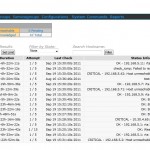
Nagios V-Shell 1.9 includes major performance updates, and a re-implementation of PHP caching that should decrease V-Shell page load times anywhere from 40-75%. I ran some benchmarking tests on a test system(Dual core desktop with 4GB of RAM) with 1800 hosts, and 7200 services. This system runs with an average CPU load of 2.0-6.0 throughout the day, so the hardware is being pushed pretty hard already from the check load. V-Shell 1.8 created page load times anywhere from 18-28 seconds throughout the interface without APC caching enabled. Needless to say, this is problematic for many users with larger environments. The Core cgi’s were able to load anywhere from 2-11 seconds, with the service status page taking around 9-11 seconds to load all of the data. My goal for 1.9 was to minimize any unnecessary processing, and optimize any functions that were inefficient or using slower PHP built-in functions. The differences in 1.9 are substantial. Without any caching enabled at all, I was able to decrease the average page load time to 9-14 seconds, which is 40-50% faster by itself. Once I had the code optimized, I reworked the APC caching functionality. If a user has PHP’s APC caching packages installed and enabled on their web server, V-Shell will cached the objects.cache file until it detects any changes in the file, while the data in the status.dat file will be cached based on a TTL (time to live) config option which now exists in 1.9. Once the data is cached in APC, the page load times throughout the interface averaged between 4-5 seconds for all pages, which is a 75% decrease in load time on average.
My goal for the next version of V-Shell is to add support for mklivestatus and ndoutils for backend data, which will eliminate the need to parse the objects.cache file and status.dat files for systems with those backends. This should further improve performance for larger installations.













